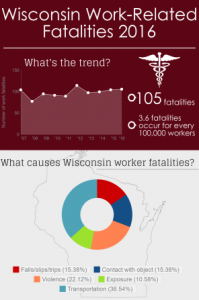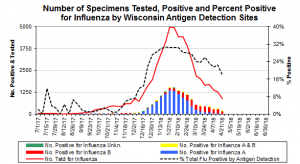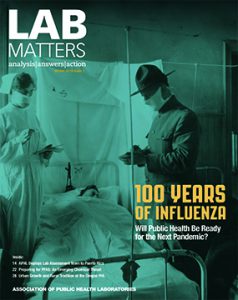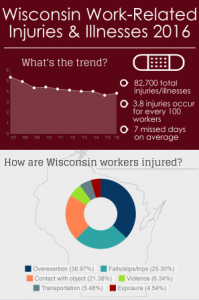
According to the U.S. Bureau of Labor Statistics’ (BLS) Census of Fatal Occupational Injuries (CFOI), there were 105 Wisconsin workers who died due to injury in 2016. This number reflects a slight increase from 104 fatalities in 2015.
Wisconsin’s overall fatality rate remained consistent from 2015 to 2016 with 3.6 deaths per 100,000 full-time workers. The number of workplace deaths in Wisconsin the past decade (2007-2016) range from 77 in 2008 to 114 in 2012, and average 97 fatalities annually.
The final count of occupational fatalities in the U.S. in 2016 was 5,190, according to figures the U.S. Bureau of Labor Statistics released last month. This was an increase from 4,836 total fatal incidents in 2015. The overall U.S. fatality rate increased from 3.4 in 2015 to 3.6 cases per 100,000 full time employees in 2016.
Key findings for Wisconsin in 2016
- The total fatal incidents decreased among industry supersectors such as Natural resources and mining, Manufacturing, and Construction (when including public sector workers across years). Increases were noted in Education and health services. Trade, transportation, and utilities remained constant from 2015, though transportation and warehousing subsectors saw decreases while wholesale and retail trade industries noted increases.
- Transportation incidents caused the most fatalities, as is typically true, though 2016 data indicate a decrease in incidents by 17 percent compared to a 21 percent increase from 2014 to 2015.
- Incidents of violence more than doubled from 11 in 2015 to 23 incidents in 2016.
- After a sharp decline from 12 incidents in 2014 to 4 incidents in 2015, female workers account for 16 fatal incidents in 2016, with 4 of those incidents attributed to workplace violence.
- Employees age 65 and over sustained the highest number of fatalities and increased from 19 incidents in 2015 to 23 fatal incidents in 2016.
Industry
In 2016, 98 of the 105 work-related deaths in Wisconsin occurred within private industry. Public sector worker deaths decreased from 9 deaths in 2015 to 7 in 2016. Agriculture, fishing, forestry, and hunting fatality count decreased from 26 to 20. Fatalities in the professional and business services industry increased from 7 in 2015 to 16 in 2016, while the trade, transportation, and utilities remained consistent at 24. Manufacturing industry deaths fell from 14 in 2015 to 12 in 2016, while fatalities in the construction industry decreased from 14 incidents (10 in private industry, 4 in the public sector) to 12 (all private ownership).
Event
Transportation incidents comprised the highest number of fatal work injuries in 2016 with 38 incidents, a decrease from 46 incidents in 2015. Falls, slips, and trips decreased slightly from 17 in 2015 to 16 incidents in 2016. Fatal contact incidents were also numbered at 16 in 2016, falling from 18 incidents in 2015. Violent events increased sharply from 11 in 2015 to 23 in 2016. Deaths due to exposure to harmful substance or environments remained consistent from 2015 to 2016 at 11 incidents.
Worker Characteristics and Occupation
Of the 105 fatalities in 2016, 9 workers were in contractor status, down from 14 in 2015. Thirty-eight were self-employed. The highest number of fatal work injuries occurred among age group 65 years and older with 23 deaths, followed by age 45 to 54 with 21, and age 55 to 64 with 20 incidents. Transportation and material moving occupations sustained the greatest number of fatal injuries in 2016 at 19 incidents, followed by management occupations with 17 deaths. Construction and extraction occupations remained consistent in 2016 at 13 fatalities, while 9 deaths occurred among installation, maintenance, and repair workers. Farming, fishing, and forestry occupations and building and grounds cleaning and maintenance occupations each indicated 8 incidents in 2016.
Background of Census of Fatal Occupational Injuries
The Census of Fatal Occupational Injuries, part of the BLS occupational safety and health statistics program, compiles a count of all fatal work injuries occurring in the United States during the calendar year. The program uses diverse state, federal, and independent data sources to identify, verify, and describe fatal work injuries. The Wisconsin State Laboratory of Hygiene (WSLH), a part of the University of Wisconsin-Madison, is the state’s public, environmental and occupational health laboratory. The WSLH’s Bureau of Labor Statistics/Occupational Safety and Health Statistics Program has a cooperative agreement with the U.S. Bureau of Labor Statistics to conduct the Census of Fatal Occupational Injuries in Wisconsin.
For more about Wisconsin Work-related fatalities, go to www.slh.wisc.edu/bls.
For more about U.S. Work-related fatalities, go to https://www.bls.gov/iif/news.htm




 Rotating Equipment Repair
Rotating Equipment Repair

